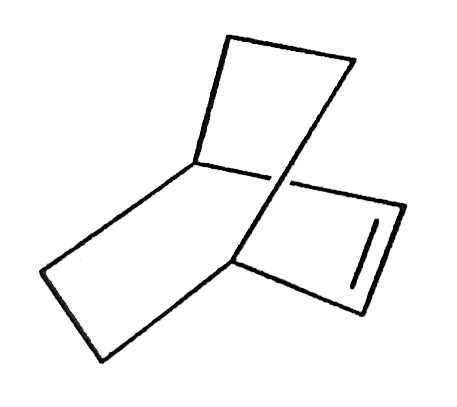A carbonyl compound (P) which gives positive iodoform test, undergoes reaction with MeMgBr followed by dehydration to give an olefin (Q). Ozonolysis of (Q) leads to a dicarbonyl compound (R ) which undergors intramolecular aldol reaction to give predominantly (S).
P1.MeMgBr−−−−−−−→2.H+,H2O3.H2SO4,ΔQ1.O3−−−−−→2.Zn,H2OR1.OH−−−−−→2.ΔS
The structure of product (S) is:
_E01_666_O01.png)
_E01_666_O02.png)
_E01_666_O03.png)
_E01_666_O04.png)
The correct Answer is:B
To solve the problem step by step, let's analyze the information given and the reactions involved.
Step 1: Identify the carbonyl compound (P)
The problem states that compound (P) gives a positive iodoform test. This indicates that (P) must be a methyl ketone or an ethanol-derived carbonyl compound. The general structure of (P) can be represented as:
R−C(=O)−CH3
Where R is any alkyl group.
Step 2: Reaction with MeMgBr
When (P) reacts with methyl magnesium bromide (MeMgBr), a Grignard reagent, it will add to the carbonyl carbon, resulting in a tertiary alcohol. The reaction can be summarized as follows:
R−C(=O)−CH3+MeMgBr→R−C(OH)(CH3)(CH3)
Step 3: Dehydration to form olefin (Q)
The tertiary alcohol formed will undergo dehydration (removal of water) when treated with an acid (H⁺) and heat, leading to the formation of an olefin (Q). The dehydration reaction can be represented as:
R−C(OH)(CH3)(CH3)H+,Δ−−−→Q
Where (Q) is an alkene.
Step 4: Ozonolysis of (Q)
Next, (Q) undergoes ozonolysis, which cleaves the double bond and forms a dicarbonyl compound (R). The ozonolysis reaction can be represented as:
QO3−→R
Where (R) is a dicarbonyl compound.
Step 5: Intramolecular aldol reaction to form (S)
The dicarbonyl compound (R) can undergo an intramolecular aldol reaction, which involves the formation of a β-hydroxy carbonyl compound followed by dehydration to yield a predominantly formed compound (S). The reaction can be summarized as:
Rintramolecular aldol−−−−−−−−−−−−→S
Step 6: Identify the structure of product (S)
The product (S) is likely to have intramolecular hydrogen bonding due to the proximity of functional groups. The structure of (S) will depend on the specific arrangement of the carbon skeleton and functional groups after the aldol reaction.
Conclusion
Based on the steps outlined, we can conclude that the structure of product (S) is predominantly formed through the intramolecular aldol reaction, resulting in a compound that exhibits intramolecular hydrogen bonding.
Final Answer
The structure of product (S) is option A.
---
The problem states that compound (P) gives a positive iodoform test. This indicates that (P) must be a methyl ketone or an ethanol-derived carbonyl compound. The general structure of (P) can be represented as:
When (P) reacts with methyl magnesium bromide (MeMgBr), a Grignard reagent, it will add to the carbonyl carbon, resulting in a tertiary alcohol. The reaction can be summarized as follows:
The tertiary alcohol formed will undergo dehydration (removal of water) when treated with an acid (H⁺) and heat, leading to the formation of an olefin (Q). The dehydration reaction can be represented as:
Next, (Q) undergoes ozonolysis, which cleaves the double bond and forms a dicarbonyl compound (R). The ozonolysis reaction can be represented as:
The dicarbonyl compound (R) can undergo an intramolecular aldol reaction, which involves the formation of a β-hydroxy carbonyl compound followed by dehydration to yield a predominantly formed compound (S). The reaction can be summarized as:
The product (S) is likely to have intramolecular hydrogen bonding due to the proximity of functional groups. The structure of (S) will depend on the specific arrangement of the carbon skeleton and functional groups after the aldol reaction.
Based on the steps outlined, we can conclude that the structure of product (S) is predominantly formed through the intramolecular aldol reaction, resulting in a compound that exhibits intramolecular hydrogen bonding.
The structure of product (S) is option A.
Topper's Solved these Questions
- ALKENE, ALKANE & ALKYNE BOOK - ALLENCHAPTER - ALKENE, ALKANE & ALKYNE EXERCISE - EXCERSISE-1
25 Videos
- ALKENE, ALKANE & ALKYNE BOOK - ALLENCHAPTER - ALKENE, ALKANE & ALKYNE EXERCISE - EXCERSISE-2
20 Videos
- ALKENE, ALKANE & ALKYNE BOOK - ALLENCHAPTER - ALKENE, ALKANE & ALKYNE EXERCISE - EXERCISE-5[A]
68 Videos
- AIIMS 2019BOOK - ALLENCHAPTER - AIIMS 2019EXERCISE - CHEMISTRY
40 Videos
- ALKYL AND ARYL HALIDEBOOK - ALLENCHAPTER - ALKYL AND ARYL HALIDEEXERCISE - EXERCISE-05 (B)
35 Videos
Similar Questions
A carbonyl compound (P) which gives positive iodoform test, undergoes reaction with MeMgBr followed by dehydration to give an olefin (Q). Ozonolysis of (Q) leads to a dicarbonyl compound (R ) which undergors intramolecular aldol reaction to give predominantly (S).
P1.MeMgBr−−−−−−−→2.H+,H2O3.H2SO4,ΔQ1.O3−−−−−→2.Zn,H2OR1.OH−−−−−→2.ΔS
The structure of products (Q) and (R ), respectively, are:
View Solution (i)O3−−−−−−−−→(ii)Zn−H2O¯:OH−−→Δ NO. of aldol condensation product.
(i)O3−−−−−−−−→(ii)Zn−H2O¯:OH−−→Δ NO. of aldol condensation product.
View Solution
Knowledge Check
Ph−CH2−O∣∣C−OH(1)NaOH,CaO,Δ−−−−−−−−−−−−−−→(2)H⊕(A)
Product (A) is :APh−CO2HBPh−CH2−OHCPh−CH3D
But-2-ene 1.O3−−−−−−−→2.Zn,H2OPOHӨ−−−−−→ΔQPd/C−−−−−→H2R
R is :
View SolutionC6H15O6(P)O3−−−−→Zn,H2OC4H8O4(Q)Molish−−−→reagent Violet colour ring
Structure of P connote be :
View SolutionH−C≡C−HHgSO4−−−−−−→H2SO4dil.NaOH−−−−−→Δ−−→P. The final product P is
View SolutionC2H2Hg(OH)21%−−−−−−−−−−→H2SO4A[O]−−→B, B is :
View Solution Hdil NaOH−−−−→[A]H2O+−−−→Δ[B]
Hdil NaOH−−−−→[A]H2O+−−−→Δ[B]
View SolutionBenzene +Cl−CH2CH2CH3AlCl3−−→P(i)O2/Δ−−−−−−−−→(ii)H2OQ+
Phenol The major products P and Q are :
View SolutionConsider the following sequence of reactions
C2H5C≡CHCH3MgBr−−−−−→A(1)HCHO−−−−−−→(2)H2O+B
The product (B) is
View Solution
